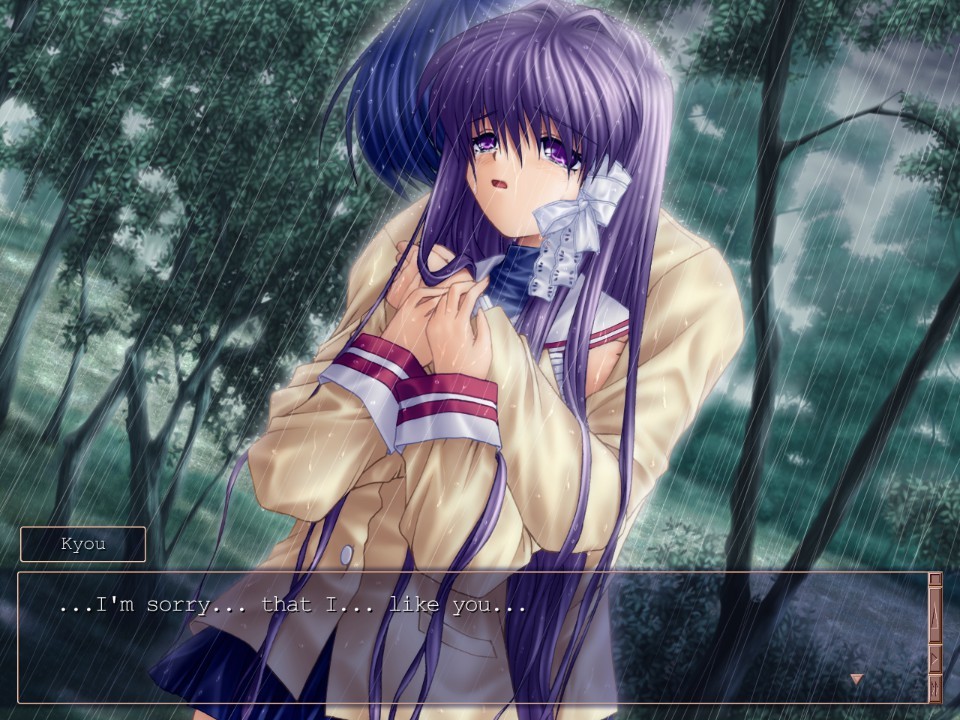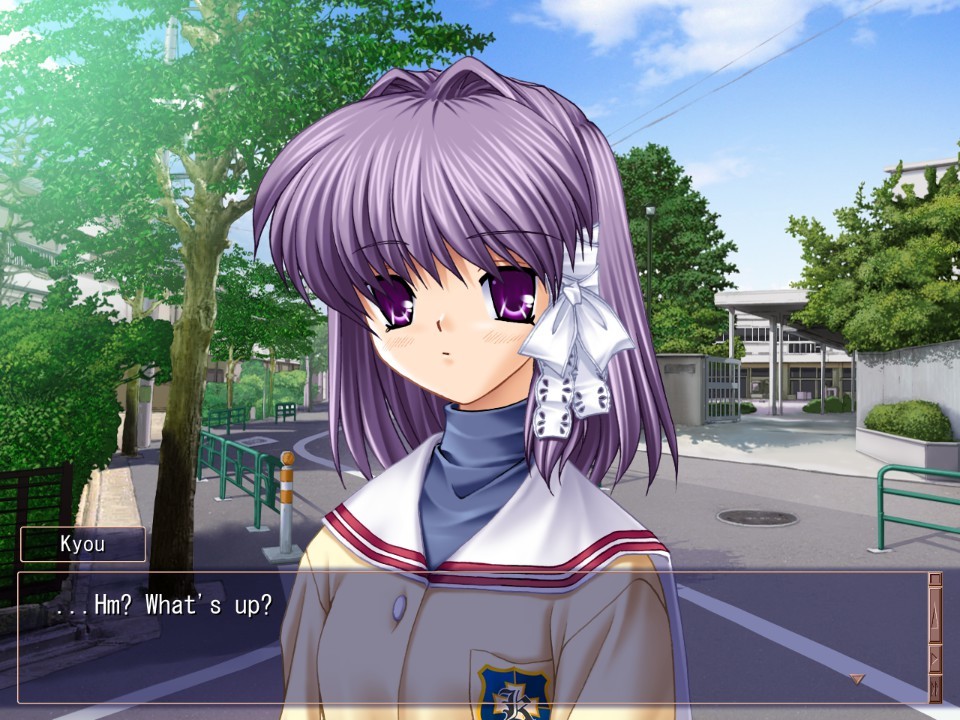Here’s a thought, the Fujibayashi route is a criticism of dating sims, and the shallow way that they approach romance. @octoberpumpkin has already noted the textual references to “event flags” and “affection rating,” which are staples of the genre. But I think the comparisons go deeper…I think the structure and events of the route itself ape the conventions of dating sims. I also think that the set of choices offered in the route are more typical of that genre, with clear “right and wrong” options. Finally, criticism is shown in that the only way to “win” in this route is to make the choices that cause Tomoya to fail.
Just to be clear here, when I say “Dating Sim,” I’m not talking about romance focused visual novels (like Clannad itself). Instead, I’m specifically talking about those statistics driven dating games where gaining enough points with a girl to establish and advance a relationship is the explicit goal (like Love Plus).
The route’s structure is repetitive, and largely focused on a set of actions that would be standard to a high school dating sim. When compared to other arcs, the Fujibayashi arc has more routine to it. Wake up, go to school, have lunch, go to town and/or home. At each of these points we have encounters: random encounters with Kyou on the way to school, lunch time with the sisters, running into the girls when in town. Moreover, this route has very few “skipped days,” and maintains the calendar when other routes are happy to simply jump forward to convenient points in the story. This is all very much like a dating sim. In these games, there are explicit locations (sometimes represented on a map) that the player can go to. At these locations, the game will have either random of scripted events, where the player can encounter one of the girls. Management of these events is central to dating sims, especially when the goal is to reach a win condition within a certain number of days.
The route’s structure has other subtle references to the dating sim genre. Tomoya gives Ryou presents, a classic way of upping a character’s “affection rating.” The fortune telling machine is reminiscent of a mini-game. And when Tomoya is near kissing either of the girls, we get a unique “close up,” reminiscent of a kissing mini-game from a dating sim. This is not something we get in other routes, and reinforces that these similarities are intentional, and not just a result of Visual Novels and Dating Sims having similar interfaces.
The options presented for Tomoya during the route are transparent, in that it is clear when you are making a choice to “gain points” for Ryou or Kyou. After the choices that get you started on the route (which I feel are also pretty transparent), our first major branch is when Tomoya is asked if he prefers “Long Hair” or “Short Hair.” Given the two girls sitting in front of him at the time, it’s pretty obvious which choice goes with which girl. Next, we get to choose if we want to practice kissing with Kyou, again an obvious choice as to which girl this applies to. Finally, we get the choice between “Amethyst” and “Tanzanite,” which, in true dating sim fashion, is a gift choice where the answer should be obvious if you’ve payed attention to what the girl’s have said. Ultimately, this all seems very “dating sim” like. Those games offer lots of opportunities to gain or lose points with the romantic interests, and while Clannad may not have a meter showing how each girl feels about Tomoya, this route does a lot to make their feelings pretty explicit.
Now, while I think I’ve done a pretty good job of establishing that the Fujibayashi route is a reference to dating sims, I still haven’t shown that it’s a criticism of the genre. This criticism comes in because the only way to “win” the route (and earn a light orb) is to “lose” at dating Ryou, and in the process you get to see pain caused when you split your affections and disregard compatibility. As others have pointed out, while the “Ryou Ending” exists, it’s not particularly satisfying, and does not result in a light orb. This is no accident. It is strongly implied that Ryou is not a good match for Tomoya, and if this were any other Key story, I don’t think Ryou would even have a romantic arc. But in dating sims, no girl is “off limits.” Pretty much every girl in those games is a viable romantic choice, and so this route does give the option of romancing Ryou. But, as a slap on the wrist for the player who does, you don’t receive a light orb for this shallow way of playing the game.
Instead, the light orb is achieved by failing at your relationship with Ryou. By splitting Tomoya’s affections, you create a painful love triangle, but one that ultimately resolves itself to earn a light orb. Each aspect of the ludonarrative here is commentary on a different player strategy. Ludologically, earning a light orb criticizes the player strategy of focusing attention on a single girl who’s a poor match. Narratively, the pain caused to everyone involved in the love triangle is a harsh criticism of splitting affections between multiple girls, another common player strategy where the player tries to achieve a “harem” by farming affection with multiple girls in a single play through.
Ultimately, I think this criticism is well deserved. Perhaps I’m biased, but I’ve always found Visual Novels to be much deeper and more meaningful experiences than Dating Sims. Not only does this route criticize dating sims using their own conventions, I feel it also does a better job of supplying a satisfying experience within those constraints. The Fujibayashi route is more than just self-indulgent fake romance, but is an engaging story that we can learn from. That’s more than I can say for the programmatic statistics-based sims it apes.




